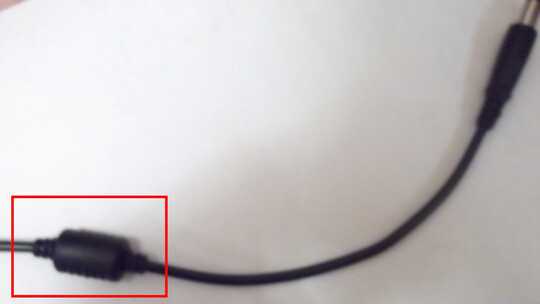83
15
There's always that pesky cylinder thing on every cable I have.

What is it?
And more importantly, why don't Apple's products have them?
83
15
There's always that pesky cylinder thing on every cable I have.

What is it?
And more importantly, why don't Apple's products have them?
35
As others have pointed out this is a ferrite core used to reduce the electromagnetic interference produced by the cable.
The European Union updated the EMC (electromagnetic compatibility) directive in 2004:
The purpose of electromagnetic compatibility (EMC) is to keep [electromagnetic interference] under reasonable control. EMC designates all the existing and future techniques and technologies for reducing disturbance and enhancing immunity.
To market an electronics product in the EU you have to comply with the EMC directive. I'm not an electrical engineer, but I would assume that slapping ferrite cores on your cables will help you comply with the directive using a "better safe than sorry" approach. Years back when these ferrite cores started appearing they were often delivered separately and you would have to fit them on the cables yourself as instructed. This was a strong indication to me that the ferrite cores was a market specific thing.
Perhaps Apple has done a proper EMC analysis and determined that the their equipment is in compliance even without ferrite cores? Or maybe you only get cables without the ferrite core for markets outside the EU?
Late addition - Wikipedia link on Ferrite Beads
+1 for addressing the apple issue, or at least an attempt to. – Jacksonkr – 2016-06-24T17:16:16.570
1Uh, looking at the collection of cables coming out of my workstation, only about half of them have these cores - this varies even on the same type of cable (2 USB to USB-mini A, one has it, other one not). All the cables were bought in the past few years from electronics shops inside the EU. Interesting...maybe USB cables don't need them, but some vendors slap them on in the hope of reducing interference? – Piskvor left the building – 2010-12-03T15:48:04.507
51
Take a look here for a very good explanation: http://computer.howstuffworks.com/question352.
They're ferrite beads used as an anti-EMI and anti-RFI measure (chokes):
Another source of noise is the cables connecting the devices. These cables act as nice, long antennae for the signals they carry. They broadcast the signals quite efficiently. The signals they broadcast can interfere with radios and TVs. The cables can also receive signals and transmit them into the case, where they cause problems. A ferrite bead has the property of eliminating the broadcast signals. Essentially, it "chokes" the RFI transmission at that point on the cable -- this is why you find the beads at the ends of the cables. Instead of traveling down the cable and transmitting, the RFI signals turn into heat in the bead.
5I believe that it is called a 'choke' by electronic engineers. – Skizz – 2010-12-03T15:47:57.380
17
Its a ferrite core, basically it reduces/filters out interference on the cable.
12And just to be sure; that's not a magnet! ;-) – Arjan – 2010-12-02T22:38:24.490
1Magnets have ferrite cores, right ? – Sathyajith Bhat – 2010-12-03T03:56:31.597
@Sathya: No, some magnets are made from ferrites, but there are lots of other materials magnets can be made from. – Sven – 2010-12-03T08:24:02.350
12
Cables act as antennas receiving high frequency signals on top of the power / data being sent over the cable. The ferrite adds inductance which attenuates or reduces the unwanted signal while allowing the lower frequency power / data to go through. They act as filters.
Ferrite cores are also found inside equipment on cabling. I suspect Apple has their filtering inside their equipment instead of on the exterior cabling.
1as for what they are, i am pretty sure all of them are just a magnet (or magnets). I'm not 100% sure on their purpose. – Xantec – 2010-12-02T22:16:01.513
if they're magnets it's probably to provide cleaner power/reduce tiny surges...I always assumed they housed little in-line fuses. – RobotHumans – 2010-12-02T22:20:16.340
thank you MaQleod, Arjan and icyrock (and digitxp for the question). i've learned someting new today as well – Xantec – 2010-12-02T22:55:30.913
20It so you can't push the cable through small holes. (Joking) – ja72 – 2010-12-03T00:15:58.970
9Apple products are Magical™ – Sathyajith Bhat – 2010-12-03T01:38:44.407
@jalexiou No, they're little microphones that spy on you, and return all the information to their manufacturers who are bent on taking over the world. (Like me.) – Mateen Ulhaq – 2010-12-03T01:41:45.090
@Sathay @muntoo So it's safe to conclude that Apple doesn't spy on you using earthly means? – digitxp – 2010-12-03T04:49:39.267
6@digitxp - No Steve Jobs is omnipresent, a little like God, and so he knows everything anyway. No need for spy equipment. – Joe Taylor – 2010-12-03T14:51:49.613
Its how the feds spy on you! Has nothing to do with apple ;-) – Moab – 2010-12-03T15:11:24.433
7For Pete's sake, if getting reputation is this easy, I've got some "thingy's" I need to ask about... – Flotsam N. Jetsam – 2010-12-03T15:58:55.287
1@Flotsam: Do it. We might all learn something interesting. – tombull89 – 2010-12-03T16:00:43.757
It's the right-hand rule – Joe Phillips – 2010-12-03T19:07:19.940
1Oh, the irony. My Civics teacher asked me what that thing was today. I was prepared. :-) – digitxp – 2010-12-03T19:18:47.317